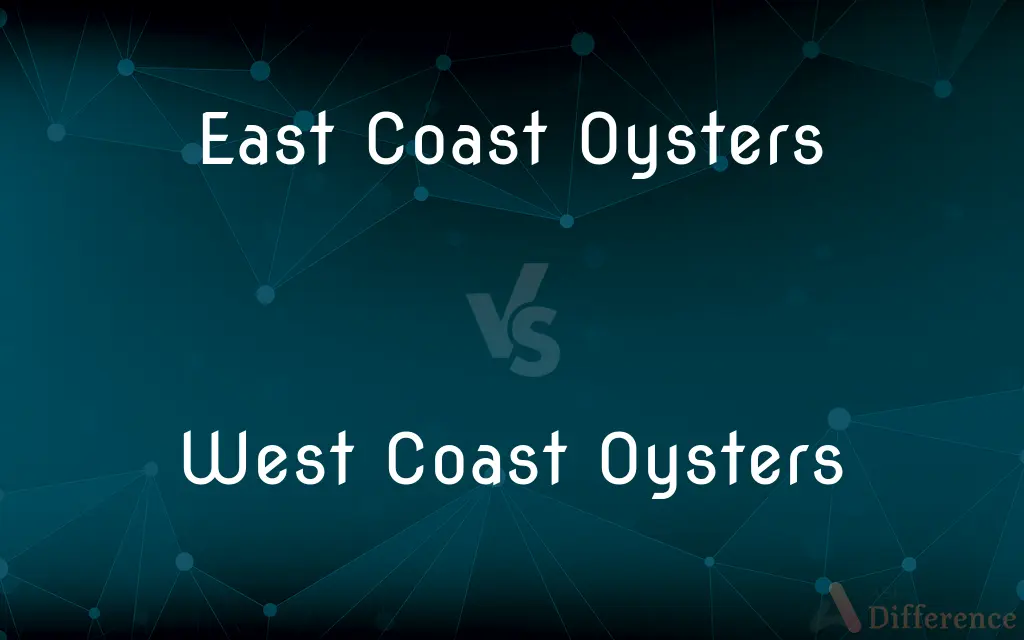East Coast Oysters vs. West Coast Oysters — What's the Difference?
Edited by Tayyaba Rehman — By Fiza Rafique — Published on November 5, 2023
East Coast Oysters come from the Atlantic seaboard and have a brinier, full-bodied flavor, while West Coast Oysters are from the Pacific coast, offering a sweeter, more delicate taste.

Difference Between East Coast Oysters and West Coast Oysters
Table of Contents
ADVERTISEMENT
Key Differences
East Coast Oysters hail from the Atlantic Ocean's shores, spanning from Canada to Florida. West Coast Oysters originate from the Pacific Ocean, stretching from Alaska down to Baja California. The distinct locations influence the oysters' growth, taste, and texture, creating marked differences between the two.
In terms of flavor profiles, East Coast Oysters tend to present a saltier, robust flavor with a meatier texture. On the contrary, West Coast Oysters often offer a more nuanced, sweeter taste with notes of cucumber or melon and a smoother texture.
One of the notable species from the East Coast is the Blue Point oyster. West Coast Oysters, on the other hand, boast popular varieties like the Kumamoto and Olympia. These species have adapted to their respective environments, resulting in their unique flavors and characteristics.
Shell shape and size can also differentiate East Coast Oysters from West Coast Oysters. Typically, East Coast Oyster shells are smoother and more elongated, while West Coast Oyster shells tend to be deeper and more fluted.
Lastly, East Coast Oysters often thrive in saltier waters, giving them their distinct briny flavor. West Coast Oysters, with their exposure to freshwater sources like streams and rain, often possess a milder salinity and a complex flavor profile.
ADVERTISEMENT
Comparison Chart
Origin
From the Atlantic Ocean, spanning Canada to Florida.
From the Pacific Ocean, ranging from Alaska to Baja California.
Flavor Profile
Saltier, robust flavor with a meatier texture.
Sweeter, nuanced taste with notes of cucumber or melon.
Popular Species
Include Blue Point oyster.
Include varieties like Kumamoto and Olympia.
Shell Characteristics
Smoother, more elongated shells.
Deeper, fluted shells.
Salinity
Thrive in saltier waters, resulting in a brinier flavor.
Exposed to freshwater sources, leading to milder salinity.
Compare with Definitions
East Coast Oysters
East Coast Oysters come in various species, including the renowned Blue Point.
For the appetizer, they served a selection of East Coast Oysters including the Blue Point.
West Coast Oysters
West Coast Oysters are native mollusks from the Pacific coast.
Tonight's special includes fresh West Coast Oysters from Washington.
East Coast Oysters
East Coast Oysters are mollusks native to the Atlantic seaboard.
The restaurant offers fresh East Coast Oysters sourced from Maryland.
West Coast Oysters
West Coast Oysters are recognized for their sweet, delicate flavors.
He was pleasantly surprised by the subtle sweetness of the West Coast Oysters.
East Coast Oysters
East Coast Oysters have a distinct, robust flavor influenced by saltier waters.
She loves the rich taste of East Coast Oysters paired with a crisp white wine.
West Coast Oysters
West Coast Oysters often have deeper, fluted shells.
The beautiful ridges on the West Coast Oysters shells caught her attention.
East Coast Oysters
East Coast Oysters are celebrated for their meaty texture and full-bodied taste.
There's nothing like the hearty flavor of East Coast Oysters fresh from the sea.
West Coast Oysters
Kumamoto and Olympia are among the famous species of West Coast Oysters.
The West Coast Oysters platter featured both Kumamoto and Olympia varieties.
East Coast Oysters
East Coast Oysters typically have smoother, elongated shells.
The East Coast Oysters on display had shiny, sleek shells.
West Coast Oysters
West Coast Oysters possess a nuanced taste, sometimes reminiscent of melon or cucumber.
The West Coast Oysters had a refreshing melon undertone that was delightful.
Common Curiosities
How do the flavors of East Coast Oysters differ from West Coast Oysters?
East Coast Oysters are saltier and meatier, while West Coast Oysters are sweeter with a more delicate flavor.
Are there different species of oysters on each coast?
Yes, each coast boasts different species, like Blue Point on the East and Kumamoto on the West.
And West Coast Oysters?
West Coast Oysters come from the Pacific coast, stretching from Alaska to Baja California.
Can I find both varieties in most seafood restaurants?
Many seafood restaurants offer both types, but availability may depend on the region and season.
Which oyster is saltier, East Coast or West Coast?
East Coast Oysters generally have a saltier, brinier taste.
Why do West Coast Oysters taste sweeter?
The presence of freshwater sources and different marine environments contribute to their sweeter taste.
Can I eat oysters raw from both coasts?
Yes, both East Coast and West Coast Oysters can be enjoyed raw, but always ensure they are fresh and from reliable sources.
What are East Coast Oysters?
East Coast Oysters are oysters harvested from the Atlantic seaboard, spanning from Canada to Florida.
Are the shells different between East Coast and West Coast Oysters?
Yes, East Coast Oysters usually have smoother, elongated shells, while West Coast ones have deeper, fluted shells.
Which oyster pairs best with champagne?
Both types can pair well with champagne, but the sweeter West Coast Oysters might complement certain champagnes better.
How should I store fresh oysters at home?
Keep them in a cool place, preferably on ice, and consume them as soon as possible.
Are there any environmental concerns with oyster farming?
Sustainable oyster farming can be beneficial to marine ecosystems, but it's essential to support eco-friendly practices.
Is one type more expensive than the other?
Prices can vary based on location, season, and demand but aren't strictly tied to coast.
How are oysters typically harvested?
Oysters are typically farmed in tidal areas using methods like bottom planting or cage cultivation.
Are there any health benefits to eating oysters?
Oysters are rich in zinc, iron, calcium, and omega-3 fatty acids, making them nutritious.
Share Your Discovery

Previous Comparison
ABA Routing Numbers vs. ACH Routing Numbers
Next Comparison
Modeling Clay vs. Polymer ClayAuthor Spotlight
Written by
Fiza RafiqueFiza Rafique is a skilled content writer at AskDifference.com, where she meticulously refines and enhances written pieces. Drawing from her vast editorial expertise, Fiza ensures clarity, accuracy, and precision in every article. Passionate about language, she continually seeks to elevate the quality of content for readers worldwide.
Edited by
Tayyaba RehmanTayyaba Rehman is a distinguished writer, currently serving as a primary contributor to askdifference.com. As a researcher in semantics and etymology, Tayyaba's passion for the complexity of languages and their distinctions has found a perfect home on the platform. Tayyaba delves into the intricacies of language, distinguishing between commonly confused words and phrases, thereby providing clarity for readers worldwide.













































